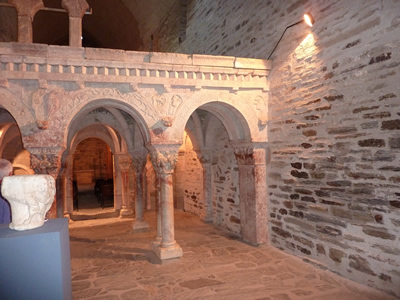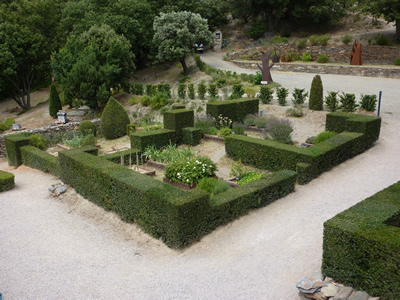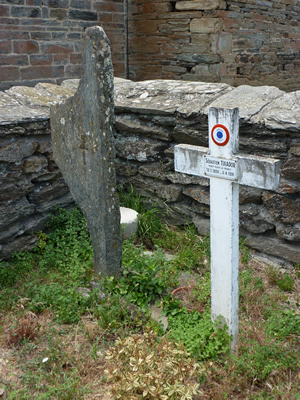It was as remote as you can imagine. We were in the foothills of the Canigou, the most important mountain in the Pyrenees if you are a Catalan. We were there for the Romanesque architecture. Well ,it is the sort of thing you do on a Sunday when you are on holiday.
We had left a quiet sun-baked road and driven along the twisty turny narrow road. On the rare occasion that a car had come in the opposite direction we had driven into the rocky undergrowth to let them pass. On their side there was quite a drop into the gorge, at the bottom of which the river Boulès dawdled. The countryside was steep, wooded and green and completely deserted. After all who would live here?
We climbed steadily. Then the signpost told us to turn off further into the hills. So we climbed further, into bright sunshine, with glorious views of the route we had taken, with the Corbieres in the background. After 10 minutes of hairpin bends, with the manic chatter of cicadas from the dry vegetation around us, we arrived at the Priory of Serrabone, or Serrabona as it is called in Catalan.
We were only about 30 km from Perpignan in the Aspres mountain range but we could have entered another world. It felt as if we had slipped further away from the things that anchor us to our time.
Sainte-Marie de Serrabona (serra bona : the good mountain) is situated in the valley of the Boulès in the heart of a densely green oak forest. The Priory had once largely collapsed and was used for many years only as a shelter for shepherds and their flocks during bad weather, of which I am sure they had plenty. It was clearly once very important, then lost and abandoned, before it was restored. Today it is a beautiful place to visit.
The place is famous for its unusual design. It is very unorthodox, with beautiful pink marble and a curious inner cloister with a window-less nave.

A dry and rather dusty botanical garden has been developed on the site to display the area’s plants.

It was certainly worth a visit. The carvings are beautiful and the setting is spectacular. Once you have paid to go in and passed the defibrillator, helpfully provided for vulnerable visitors, you can pick up details about the priory and its history.
They tell you that one of the priors was dismissed for doing something unspeakable in the fifteenth century. That was good enough for me. After all, it requires very little imagination to link him to that other local attraction, the mysteries of Rennes le Chateau. It could be a new dimension to The Holy Blood and the Holy Grail and The Da Vinci Code. And of course in these circumstances no one needs to be troubled too much by evidence.
It was hard to drive up to Serrabone and then down again, but it must have been much harder to walk. In fact the Priory is on one of the walking routes through to Spain for pilgrims going to St John de Compostella. It must have been very very difficult.
There is a cemetery there and of course I couldn’t resist it.

It is old and neglected, rather overgrown in parts. I am sure it receives few visitors. There are mounds of earth and forgotten headstones that mark the end of forgotten lives. What a hard life it must have been up here in the mountains. How isolated, how introverted, how intense.
However, the tentacles of war even reached these remote parts of the Pyrenees. There was the grave of a French soldier, Sebestien Tixador. who died on 6 April 1918.

The battlefields of Northern France must have seemed completely alien. Next to him was a broken headstone, eroded by the weather into a strange and dramatic shape, adding to the sense of mystery that surrounded the priory.

We looked for a while at the graves of Alphonsine and Yvonne Moragas, the former originally also a Tixador. There were probably not many surnames in use up here. We looked at a past and a family history slipping away. They are now merely names on a headstone, small secrets in a landscape that holds many secrets.
The long descent to civilization, or at least to Amelie les Bains, was 33 kilometres but it took us 45 minutes, although this included a wait when a herd of unaccompanied goats blocked the road